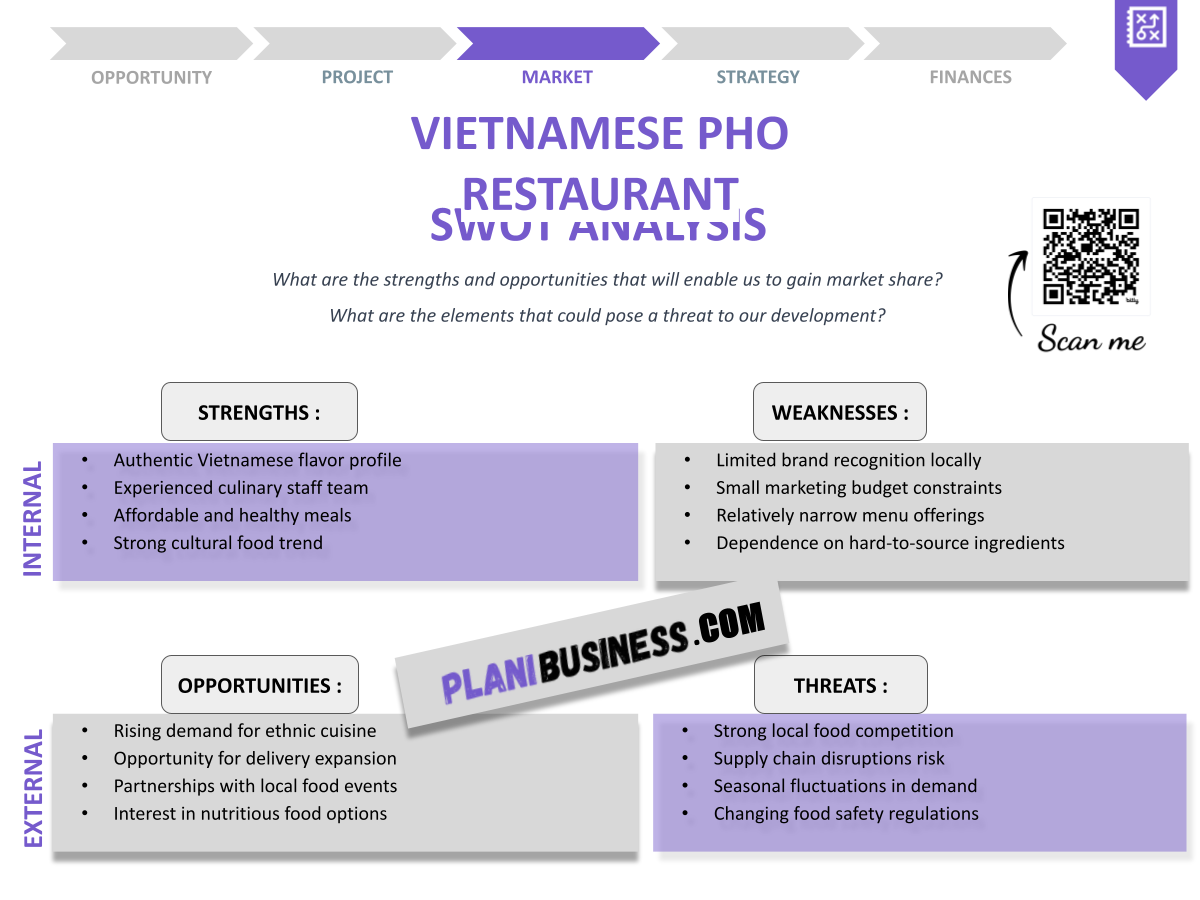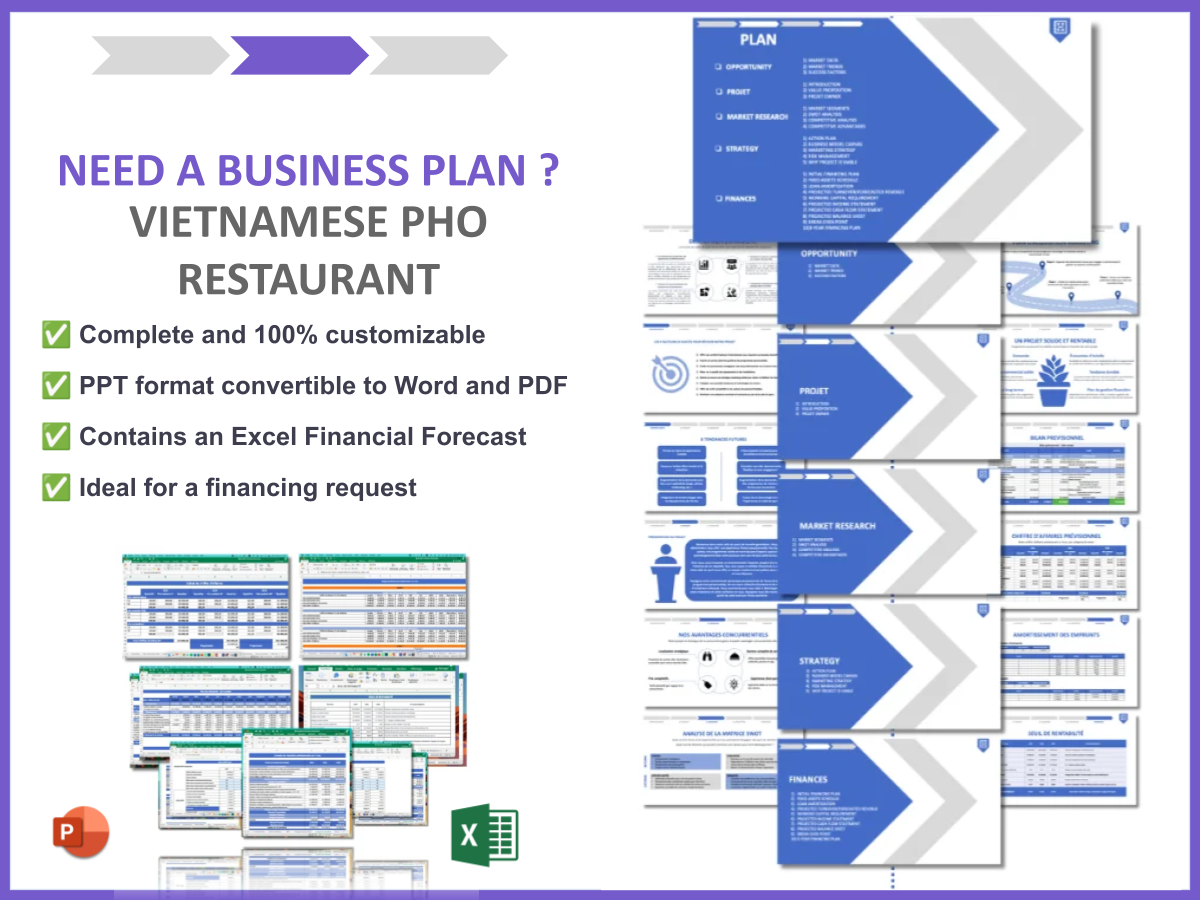Why Should You Have a SWOT Analysis for Your Vietnamese Pho Restaurant?
Are you thinking about starting a Vietnamese Pho restaurant? You’re not alone! With the growing popularity of Vietnamese cuisine, many entrepreneurs are diving into this delicious market. But before you take the plunge, it’s crucial to assess your business potential. A SWOT analysis is a strategic tool that helps you identify your restaurant’s strengths, weaknesses, opportunities, and threats. This insight is invaluable for making informed decisions that can lead to success.
Surprisingly, over 70% of new restaurants fail within the first three years, often due to a lack of planning and strategy. By utilizing a SWOT analysis, you can gain clarity on what sets your Pho restaurant apart and how to navigate the challenges of the food industry.
A SWOT analysis for your Vietnamese Pho restaurant involves evaluating internal factors, such as your unique recipes and customer service, alongside external factors, like market trends and competition. This comprehensive approach not only enhances your understanding of the food industry but also helps you craft a targeted business strategy.
- Understand the importance of a SWOT analysis for restaurants.
- Learn how to identify strengths specific to a Pho restaurant.
- Recognize common weaknesses in the restaurant industry.
- Explore opportunities in the growing Vietnamese food market.
- Identify potential threats to your restaurant’s success.
- Review 10 practical examples of SWOT analyses from successful Pho restaurants.
- Discover actionable strategies based on these examples.
- Gain insights into market trends affecting Vietnamese cuisine.
- Learn how to leverage your restaurant’s unique offerings.
- Prepare to adapt your business strategy for long-term success.
How Do You Write a SWOT Analysis for a Vietnamese Pho Restaurant?
Writing a SWOT analysis involves gathering information about your restaurant and the market. It’s about being honest and thorough in evaluating what you have and what you face in the competitive landscape.
Strengths
A strong menu featuring authentic Pho recipes can set your restaurant apart. Additionally, high-quality ingredients can build a loyal customer base. Moreover, a well-trained staff can enhance customer experience, while unique branding can attract a niche audience.
Weaknesses
On the flip side, limited marketing efforts can hinder visibility. High operational costs may affect profitability, and inexperience in the food industry can lead to mismanagement. Lastly, a lack of customer feedback can stifle improvement.
Opportunities
There are several opportunities to explore. The growing trend of healthy eating favors Vietnamese cuisine, and expanding delivery options can reach more customers. Collaborating with local businesses can enhance community ties, and seasonal menus can attract repeat customers.
Threats
However, you must also be aware of potential threats. Increased competition from other Vietnamese restaurants can dilute market share, while economic downturns can reduce discretionary spending. Supply chain disruptions can affect ingredient availability, and changing consumer preferences may require menu adjustments.
SWOT Example N°1 for a Vietnamese Pho Restaurant
Here’s a real-world example of a Vietnamese Pho restaurant that effectively utilized a SWOT analysis.
| SWOT | Analysis |
|---|---|
| Strengths | Authentic recipes, high-quality ingredients |
| Weaknesses | Limited marketing budget |
| Opportunities | Growing interest in Vietnamese cuisine |
| Threats | New competitors entering the market |
- Authentic Pho recipes.
- Strong customer loyalty.
- Limited visibility in the local market.
- Increasing competition.
Using a SWOT analysis allowed this restaurant to leverage its strengths while addressing its weaknesses, ultimately leading to improved visibility and customer engagement.
SWOT Example N°2 for a Vietnamese Pho Restaurant
Another great case study showcases how a Pho restaurant navigated its challenges through a SWOT analysis.
| SWOT | Analysis |
|---|---|
| Strengths | Experienced chefs, unique ambiance |
| Weaknesses | High operating costs |
| Opportunities | Catering services for events |
| Threats | Rising food prices |
- Experienced culinary team.
- Unique dining experience.
- High costs impacting profits.
- Price fluctuations affecting supply.
This example highlights the importance of capitalizing on strengths like an experienced kitchen staff while also addressing the threat of rising costs.
SWOT Example N°3 for a Vietnamese Pho Restaurant
Here’s how another restaurant utilized its SWOT analysis effectively.
| SWOT | Analysis |
|---|---|
| Strengths | Strong online presence, customer reviews |
| Weaknesses | Small physical space |
| Opportunities | Partnership with food delivery services |
| Threats | Health crises affecting dining out |
- Strong online marketing.
- Positive customer feedback.
- Limited seating capacity.
- Vulnerability to health regulations.
This restaurant’s online presence allowed it to thrive even during difficult times, showcasing the power of adaptability.
SWOT Example N°4 for a Vietnamese Pho Restaurant
This example illustrates how a restaurant effectively managed its SWOT analysis.
| SWOT | Analysis |
|---|---|
| Strengths | Diverse menu options |
| Weaknesses | Seasonal customer fluctuations |
| Opportunities | Hosting community events |
| Threats | Economic instability |
- Varied menu appealing to different tastes.
- Seasonal business challenges.
- Community engagement opportunities.
- Economic challenges impacting spending.
Community engagement through events helped mitigate seasonal fluctuations, demonstrating a proactive approach to challenges.
SWOT Example N°5 for a Vietnamese Pho Restaurant
A unique case that showcases effective strategic planning.
| SWOT | Analysis |
|---|---|
| Strengths | Strong brand identity |
| Weaknesses | Limited staff training |
| Opportunities | Expansion into new markets |
| Threats | Negative reviews on social media |
- Recognizable brand image.
- Staff training gaps.
- Potential for market expansion.
- Impact of online reviews.
By addressing staff training, this restaurant can enhance customer satisfaction and leverage its strong brand identity.
SWOT Example N°6 for a Vietnamese Pho Restaurant
This example showcases how a restaurant effectively managed its SWOT analysis.
| SWOT | Analysis |
|---|---|
| Strengths | Loyal customer base |
| Weaknesses | Limited marketing outreach |
| Opportunities | Collaborations with local farms |
| Threats | Increased ingredient costs |
- Dedicated clientele.
- Marketing challenges.
- Local sourcing opportunities.
- Rising costs of ingredients.
By focusing on local sourcing, this restaurant can not only enhance its menu but also strengthen its community ties.
SWOT Example N°7 for a Vietnamese Pho Restaurant
Here’s how another Pho restaurant navigated its SWOT analysis.
| SWOT | Analysis |
|---|---|
| Strengths | High customer satisfaction |
| Weaknesses | Lack of online ordering system |
| Opportunities | Expanding social media presence |
| Threats | Changes in consumer habits |
- High customer ratings.
- Absence of online ordering.
- Growth potential on social media.
- Shifts in dining preferences.
Implementing an online ordering system could significantly increase this restaurant's reach and adaptability to consumer habits.
SWOT Example N°8 for a Vietnamese Pho Restaurant
This example shows another restaurant’s strategic approach.
| SWOT | Analysis |
|---|---|
| Strengths | Authentic flavors |
| Weaknesses | High staff turnover |
| Opportunities | Online cooking classes |
| Threats | Increased competition |
- Authentic culinary experience.
- Staffing challenges.
- Innovative marketing opportunities.
- Competitive market landscape.
Offering online cooking classes could leverage the restaurant's strengths while creating additional revenue streams.
SWOT Example N°9 for a Vietnamese Pho Restaurant
A compelling case study from the Pho restaurant industry.
| SWOT | Analysis |
|---|---|
| Strengths | Unique signature dishes |
| Weaknesses | Limited geographic reach |
| Opportunities | Catering for corporate events |
| Threats | Economic downturns affecting dining |
- Signature menu items.
- Geographic limitations.
- Catering potential.
- Economic vulnerabilities.
By exploring catering opportunities, this restaurant can broaden its market reach beyond its physical location.
SWOT Example N°10 for a Vietnamese Pho Restaurant
A final example showcasing strategic insights.
| SWOT | Analysis |
|---|---|
| Strengths | Strong community relationships |
| Weaknesses | Inefficient supply chain |
| Opportunities | Food festivals and fairs |
| Threats | Rising rental costs |
- Community engagement.
- Supply chain issues.
- Festival participation potential.
- Rising operational costs.
Participating in local food festivals can strengthen community ties while boosting visibility and sales.
Final Thoughts on SWOT Analysis for Vietnamese Pho Restaurants
In conclusion, conducting a SWOT analysis is essential for any Vietnamese Pho restaurant aiming for success. By understanding your strengths, weaknesses, opportunities, and threats, you can make informed decisions that drive your business forward. Remember, the restaurant industry is dynamic, and regularly updating your SWOT analysis will keep you competitive and adaptable.
If you’re serious about launching your own restaurant, consider checking out this business plan template for a Vietnamese Pho Restaurant. It provides a structured approach to get your business off the ground.
Additionally, you might find these articles helpful: learn How to Build a Vietnamese Pho Restaurant? and explore How to Initiate a Vietnamese Pho Restaurant Marketing Plan? With Example.
Frequently Asked Questions
1. What is a SWOT analysis?
A SWOT analysis is a tool used to evaluate the strengths, weaknesses, opportunities, and threats related to a business or project.
2. Why is a SWOT analysis crucial for restaurants?
It helps restaurant owners to understand their market position and to formulate strategies for improvement and growth.
3. How frequently should I perform a SWOT analysis?
It is recommended to conduct a SWOT analysis at least once a year or whenever significant changes occur in the business environment.
4. Can a SWOT analysis enhance marketing strategies?
Yes, it identifies marketing strengths and opportunities that can improve your restaurant’s visibility and customer engagement.
5. What are typical weaknesses found in restaurants?
Common weaknesses include high operational costs, ineffective marketing, and staffing issues.
6. How can I utilize opportunities identified in a SWOT analysis?
Leverage opportunities to expand your market reach, improve your menu, or engage with customers more effectively.
7. What threats should I be aware of in the restaurant industry?
Potential threats include competition, economic downturns, and shifts in consumer preferences.
8. How does a SWOT analysis influence decision-making?
It offers a clear framework for evaluating strategic options and prioritizing actions based on both internal and external factors.
9. What role does community involvement play in a SWOT analysis?
Strong community relationships can be a significant strength and opportunity for restaurant growth and customer support.
10. Is it possible to conduct a SWOT analysis alone?
While you can perform it individually, involving your team can provide diverse insights and a more comprehensive analysis.







